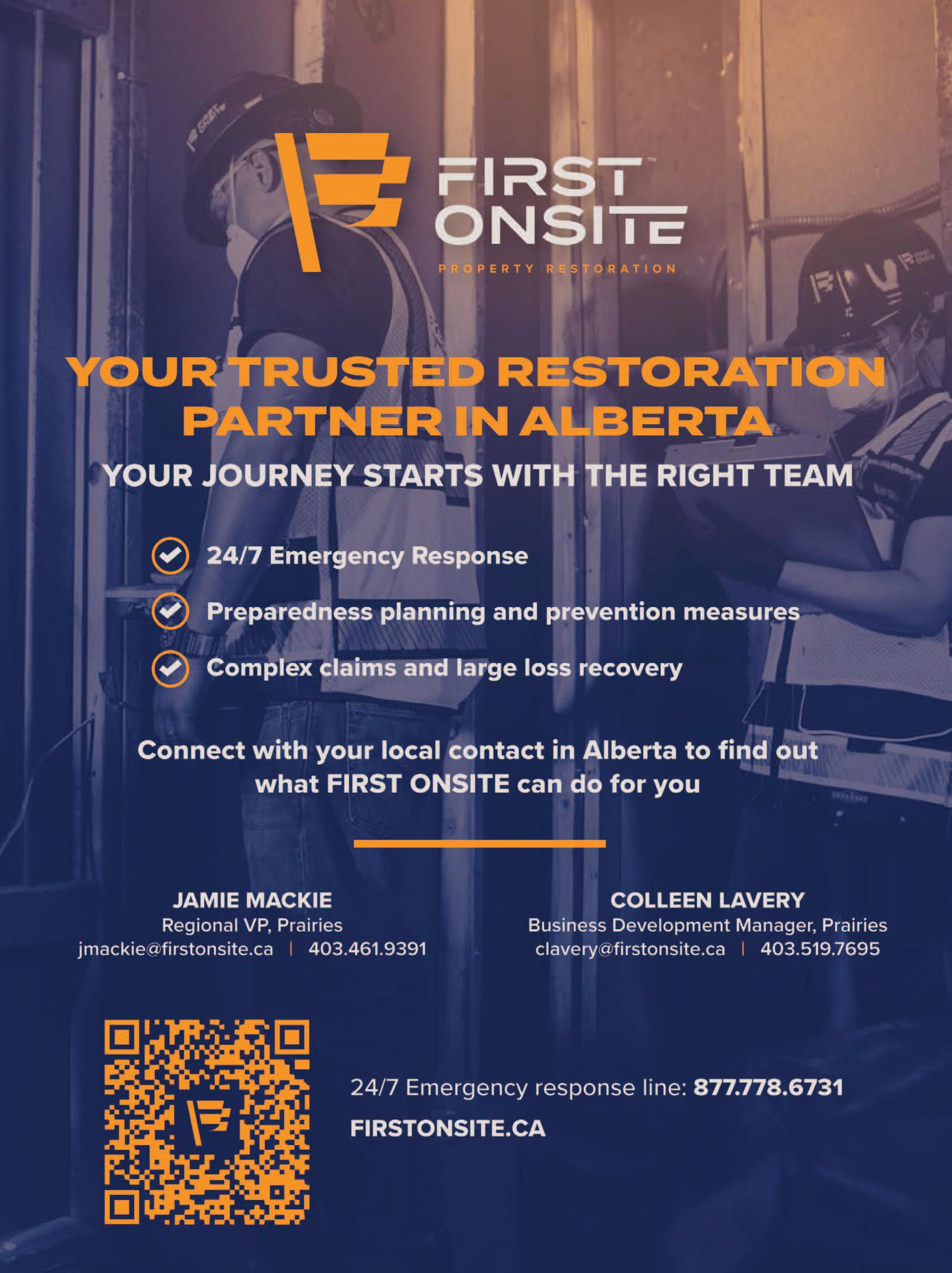
FOCUS ON AI
IMPACT ON INSURANCE BROKERS
Q&A WITH INSURERS
AIRB’S COMPANY SURVEY RESULTS
+2024 IBAA Convention Guide

Developing Valuable New Brokers E&O: Insure Properties to Value and more—











IMPACT ON INSURANCE BROKERS
Q&A WITH INSURERS
AIRB’S COMPANY SURVEY RESULTS
+2024 IBAA Convention Guide

Developing Valuable New Brokers E&O: Insure Properties to Value and more—









ime sure passes quickly. It seems like just yesterday that we were holding our 2023 annual general meeting and I was elected as IBAA president. Now here I am, a year older, hopefully a year wiser, and certainly more experienced.
I started this with great hope to be a part of a better future for brokers and I would like to think that every day we continue to work toward that goal. This has certainly been an interesting year, full of challenges and opportunities. However, I am happy to be able to say that we met them all head on and we continue to strive for a brighter future for our industry.
Throughout this year, we have continued our efforts to work with the provincial government to develop solutions to the issues around personal auto and the need for long-term reforms. Jhnel and I, and others on our board and executive, have met with numerous MLAs and ministers over the past few months including Finance Minister Nate Horner, Transportation Minister Devan Dreeshen and our new superintendent of insurance, Chris Merriman. We have received encouraging feedback from some, including the offices of the finance minister and the superintendent. However, as we all know, these reforms are still being developed and need to be implemented in a way that minimizes impact and maximizes improvement. With this in mind, we have put together a broker advocacy task force to mobilize as many brokers as possible across the province to meet with MLAs and to keep the need for
insurance reform front of mind for our government and the opposition. Where possible, we are also working with IBC to present a clear and unified message on the needs of the brokers, insurers and consumers of this province.
These initiatives are just a few of the areas that we have been advocating for brokers and our industry. This work continues at a frenetic pace as the need for improvement in our regulatory environment grows. I know that the latest developments in personal insurance from our provincial government continue to be cause for great concern, but I can say with confidence that IBAA will continue to do all in our power to fight for the brokers of this province.
“I believe that brokers need to do a better job of championing ourselves for the work that we do and that the impact of the broker cannot be overstated. This will become even more vital as government seeks cost reductions in our industry”
Moving forward, I am happy to turn the reins over to the capable hands of Caleb Maksymchuk, our new president. Caleb has been in this industry for many years and, like me, is a past president of the Professional Young Insurance Brokers (PYIB). I am excited for the direction of IBAA under Caleb’s leadership and I ask you all to join me in extending a warm welcome to him.
I know that the coming year will present its own unique challenges, as well as the continuation of some old ones, but I am cautiously optimistic that we will see brighter days ahead as we continue our work to implement needed reforms. I know that the brokers of Alberta are some of the best, most caring, dedicated, intelligent and innovative people that I have ever met and I expect great
things from our industry in the years to come. Brokers are economic drivers within their communities and the province as we work to protect the assets and livelihoods of our customers. I believe that brokers need to do a better job of championing ourselves for the work that we do and that the impact of the broker cannot be overstated. This will become even more vital as government seeks cost reductions in our industry. Brokers are the experts that consumers need and rely on, and our value to the industry cannot be overstated.
Before I go, I want to say thank you to a few very important people. Thank you to Barry Haggis as he ends his time as past president and moves off our board. Barry, you will be missed around the table and your good humor, quick mind and dedication to brokers will be the legacy that you leave behind. Thank you as well to Jhnel WellerHannaway. I cannot say enough about the impact you
have made in the short time you have been our CEO and I am really looking forward to seeing what you are able to accomplish in the future. I know that it has been stressful at times as you work to improve our association but I can already see the impact of your efforts. In addition, this section would not be complete without thanking all of the board members that have donated their considerable talent and time to our association during my time as president, as well as the efforts of our office staff to bring our vision to fruition. Last but not least, I also say a huge thanks to all of our members who we work so diligently for. I am looking forward to seeing all of you at convention in Banff again this year from May 5-8, to connect, learn and have some fun together.
In closing, I am proud of the work we have accomplished, I am hopeful for the future, I am mindful of the work still to come and I am grateful for the opportunity to serve as your president for the 2023/2024 term. I am looking forward to becoming past president and to what my successors will bring.


“I thought I was fully covered for everything.” Does that phrase sound familiar? It should, because we’ve heard it said by claimants in errors and omissions claim after errors and omissions claim. Why does the insured have inadequate limits?
Because you assured them— incorrectly, it turns out—that they were “fully covered for everything.” To make matters worse, you never mentioned a thing about coinsurance or replacement cost, which is how— they solemnly explain in court—they wound up with a severely underinsured loss.
Over the past decade, Marshall & Swift/Boeckh1 estimate that some 60% of residential homes in the U.S. market
are undervalued by roughly 15-20 per cent—and that was before the recent explosion in construction costs caused by supply chain issues, hurricanes, wildfires and the pandemic. You’ve of course heard that the annual rate of inflation was as high as 8% in January 2022 and is now around 3%2 , but the cost to repair or rebuild a damaged residential property in Canada is up by about 6% on average over the last
continued on page 8





year, according to the “eleven census metropolitan area composite” and up on average 22.5% since the end of 2021 for an annual average of 11.25%. (Statistics Canada’s “eleven census metropolitan area composite” represents Canada’s 11 major metropolitan areas. —Editor) For non-residential building the increase was 5% in 2023 and 17% since Q4 of 2021 for an annual average of 8.5%. 3 There is great variability from region to region and a region with a low increase in construction cost for non-residential might have a greater increase for residential building and vice-versa.
Consider the implications of the number of underinsured properties in the context of your business. The odds are, many of your customers were already underinsured by their own choice but, even if their policy limits were exactly where they needed to be a year or two ago, inflation has put even those sensible customers at risk of incurring a coinsurance penalty.
In Canada over the last two years, we’ve experienced record wildfires, hurricanes, a billion-dollar derecho, floods and severe rainstorms. If you’re like the vast majority of brokers, you have a lot of customers concentrated in a relatively small geographic region. What if it gets hit by one of those weather phenomena? You could wind up with dozens of claims involving customers whose limits are not enough to repair or rebuild their property.
Sadly, given the number of customers who have claims each year and the likelihood that inflationary pressures have rendered their limits inadequate, it won’t take a catastrophe to have claimants—and their attorneys—lined up at your door.
There is, however, a silver lining to this ominous, dark cloud. In ordinary times, if you asked a customer if they would like a quote with higher limits, their inevitable response would be, “Why?” And in ordinary times, your sensible reply—that it makes good
sense to reassess limits periodically to ensure that the property is insured to value—would have often been met with a shrug or “Maybe next year …”
This year is different, and these are not ordinary times. Plus, inflation is very much in the news these days, so your suggestion that it is time to revisit limits and your explanation are much more likely to be heard. It’s also a good time to explain and send documentation about coinsurance so they understand the risk of being underinsured.
Needless to say, your offer of a quote with higher limits should be made in writing and you need to follow up to close the loop. If your customer still insists upon sticking with their current limits despite your explanation, that’s their decision to make. Just be sure you document it, ideally with a written communication confirming their decision.
If they express interest? Do not offer to assess the replacement cost of their property yourself—not unless you have serious training that qualifies you to make such an assessment, especially considering rapidly escalating prices. Ideally, their current property carrier will be willing to make that calculation. If not, be prepared to suggest a local professional resource, such as an appraiser or construction company, that can offer an expert opinion about the replacement cost of the property.
If the expense scares them off, suggest fallback options like an estimator program that calculates replacement cost based on location, square footage, construction type and a variety of other factors that your customer—not you—should provide. The insured is the best person to provide this data as we have seen many E&O claims resulting from errors made when inputting those key variables.
Once your customer has arrived at the correct value, obtain written quotes based on that figure. If the carrier has an available guaranteed replacement
cost coverage endorsement, offer that, too. Again, document your customer’s response, and if it is a yes, get the new limit in place immediately. Remember: too little, too late is no good for anyone.
Yes, this does sound like a lot of work, but bear in mind that many of these efforts will result in higher commissions for you as a benefit of helping your customer. Still not convinced? Count the number of property policies written through your brokerage firm, then determine what the deductible is on your E&O policy—and the aggregate, if you’re lucky enough to have one.
The real question isn’t whether you can afford to make the effort required to contact all these customers; it’s whether you can afford not to.

This article is intended to be used for general informational purposes only and is not to be relied upon or used for any particular purpose. Swiss Re shall not be held responsible in any way for, and specifically disclaims any liability arising out of or in any way connected to, reliance on or use of any of the information contained or referenced in this article. The information contained or referenced in this article is not intended to constitute and should not be considered legal, accounting or professional advice, nor shall it serve as a substitute for the recipient obtaining such advice. The views expressed in this article do not necessarily represent the views of the Swiss Re Group (“Swiss Re”) and/or its subsidiaries and/ or management and/or shareholders.
1 https://www.insurancebusinessmag.com/ us/news/breaking-news/most-propertyowners-do-not-have-enough-coverage-torebuild-25352.aspx
2 https://www.statcan.gc.ca/en/subjects-start/ prices_and_price_indexes/consumer_price_ indexes
3 https://www150.statcan.gc.ca/n1/pub/71607-x/71-607-x2022013-eng.htm
4 https://natural-resources.canada.ca/simplyscience/canadas-record-breaking-wildfires2023-fiery-wake-call/25303




hether it’s the regulatory environment, workforce demands, client expectations, industry consolidation, inflationary pressures or economic factors, there is no shortage of landscape changes that Alberta’s insurance brokers must navigate. But one change promises a landscape shift of seismic proportions: artificial intelligence (AI).
How insurers currently or plan to use and leverage AI in their operations has a significant impact on insurance brokers and the clients they serve. The Alberta Broker reached out to insurance company executives to participate in a Q & A exercise focused specifically on AI-related issues, and we thank the following individuals for taking the time to respond:
Ben Isotta-Riches Chief Distribution Officer Aviva CanadaRowan Saunders
President & CEO
Definity
Isabelle Girard
SVP, Chief Digital & Data Officer
Intact Financial Corporation
Tracy Riley
SVP & Chief Insurance & Technology Officer
Wawanesa Mutual Insurance Company
What specific AI initiatives has your company implemented so far, and what has been the impact on operations?
AVIVA
Technology will have many transformative effects on the P&C insurance industry. At Aviva, we’ve implemented an array of AI solutions in pricing, claims and other areas of risk management. For our teams and partners, this has meant improved operational efficiency through process automation.
BY ANNETTE HUBICKA great example of how our teams have been able to unlock the potential of its applications is through our AI-powered pricing model, which allows us to offer competitive and personalized rates to our customers based on their individual profiles, behaviour and needs.
Right now, the advantages are most evident in claims processing. This is a critical workflow that directly impacts customer satisfaction and operational efficiency. Through the implementation of these new tools, we’ve been able to automate steps like repair shop routing, and case triage and assignment to reduce resolution times, costs and improve accuracy for our customers and efficiencies for our claims teams at Aviva.
At Definity we are fortunate to have over 25 years of high-quality, digitized
data at our disposal. We leverage over 125 predictive models across the insurance value chain to improve profitability, growth and the customer experience, including partnerships with specialized AI insurtech vendors. Predictive modelling is foundational to our pricing, underwriting and risk selection in all lines of business. Outside of pricing, many of the significant improvements to our run-rate annual profitability over the past five years have been enabled by analytics. Other applications of AI in our business have allowed us to enhance underwriting, claims handling, fraud detection, targeted marketing and distribution strategy.
Our investment in artificial intelligence and using AI to improve the insurance experience for customers, brokers and employees is unmatched in the Canadian market. We have invested heavily since 2017 in AI to improve speed, efficiency and the overall customer experience. Our use of AI has allowed us to help detect fraudulent claims, better price our products and improve call quality for customers. Our speech analytics implementations have shown improvements in call effectiveness and efficiency for contact centers, sales agents and claims adjusters, and we have also rolled out an AI-based tool for personal auto total Losses, which reduces appraisal times. We’re always looking for ways to connect innovation and technology to better the customers and broker experience and, as such, we are planning to continue to roll out new and current tools to our various teams.
Wawanesa is actively exploring how artificial intelligence can increase our overall productivity and improve our operations. For example, we’re using Microsoft Copilot to see how it can help us do simple tasks faster. We’re also using AI to speed up
our commercial quote process by automating some of the manual work. This means our employees can spend more time helping our members and brokers directly.
What are your company’s future plans for AI adoption and innovation? Are there specific areas within the company where you anticipate further integration of AI technologies?
We’ve been using AI solutions at Aviva for several years now. Now, we’re taking a significant step forward by looking at how we can adopt and use the advancements of generative AI-powered tools. Tools that could help our people remove some of the administrative load, especially from repetitive tasks, boost productivity and add value to customers, are attractive and areas where we’re focusing on right now. This is all still relatively new to the insurance industry, but we do anticipate greater integration of tools that can support our business, people, partners, brokers and your customers.
Our company has been using AI and machine learning to improve the customer experience and make the business run more smoothly in a safe and ethical way for almost 10 years. We continue to invest in data, analytics and AI capabilities to deliver on our business strategy and we don’t see that pursuit slowing down. In 2022, we entered a strategic partnership with Google, which has accelerated our use of AI in underwriting, fraud detection, claims management, communications and IT functions. With the recent advent of generative AI, we have been exploring numerous opportunities to apply generative AI’s automation, communication and personalization capabilities to improve productivity and efficiency and personalize customer experiences. For example, in October
2023, we began using generative AI to support our contact centre employees. This technology has reduced average call time by about three minutes, allowing customer care associates to increase their focus on value-added customer and broker service.
Our goal is to have three out of four customers interacting with us digitally, and to make it easier for brokers to do business with us. We’ve listened to customers and our broker network and know there is a desire for services that are simpler, faster, and increasingly more digital. We’ve developed industryleading platforms and are forging ahead in our exploration of generative AI to identify if, and how it can be used in a safe and secure way. Our use of AI is a priority and an investment—our ambition is to be a global leader in artificial intelligence in the insurance industry, a goal that we’re well on our way to achieving. Through it all, we’re focused on ensuring our AI innovations benefit brokers, allowing them to work more efficiently with us and to deliver superior service to customers.
We’re planning to use more artificial intelligence and advanced technology to improve our members’ and brokers’ experiences. This includes speeding up simple tasks and delivering information faster. We’ll keep using new technology to improve our business and our overall productivity, while being careful and considering the benefits and risks.
How is your company addressing concerns related to AI such as data privacy, security vulnerabilities and algorithmic bias?
We’re committed to ensure compliance with the ethical use of client data in all initiatives, including AI, as protecting our customers is a top priority.
Some of the ways in which we’re addressing concerns is through controls such as implementing bias detection algorithms, diversifying training data, and conducting regular audits of our AI models and processes. We have an AI risk and control framework that outlines safeguards we have in place to protect and prevent undesirable outcomes. This includes controls such as AI initiatives being reviewed by subject matter experts, second line risk and compliance, privacy and information security prior to implementation. It also covers privacy impact assessments and legal/compliance reviews.
We strive to be the Canadian P&C industry leader in our application of data & analytics ethics, in alignment with Definity’s purpose to build a better world. In 2021, Definity developed a Data Usage Ethics Standard that establishes an ethical framework governing the use of AI and machine learning tools. In 2022, Definity began developing a practical set of tools that Definity’s actuarial and analytics practitioners use to perform bias and fairness assessments when developing predictive models and to reduce bias if detected. In 2023, we embedded these bias and fairness detection tools into standard modelling workflows and processes. We have also developed an escalation process when our practitioners confront ambiguous situations that benefit from diversity of opinions to resolve. Additionally, Definity’s strategic partnership with Google drives towards ensuring that private data is kept private: by design, it never leaves our secure Cloud environment and is not used to train Google’s AI models.
It’s good to be at the forefront of technologies, but it’s also important that AI and its use align with our philosophy, approach and core values. To build a world class AI foundation, we have developed a balanced and



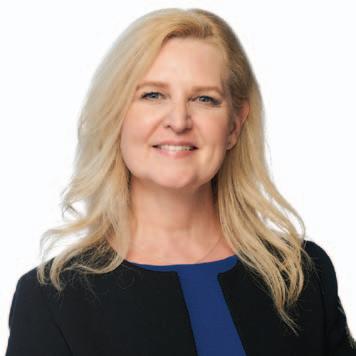
responsible approach to the use and oversight of data and AI models that protects privacy. We have established a set of guiding principles that include security, accountability and data quality, to help us navigate these tools and our use of them. We see cyber as a deep trend the insurance industry must address collaboratively, so we don’t just look at our security. We work closely with brokers to support their improvement of their cyber awareness and security.
Our approach to addressing concerns related to AI is grounded in our values as a mutual company, which includes being open, transparent and fair. We always try to do the right thing for our members, no matter what new technology comes along. We’ve also developed “Responsible Use of Artificial Intelligence Principles” to guide our use of AI.
How and when will your plans for AI implementation impact the way brokers do business?
At Aviva, when we look to the future and how we can best integrate generative AI solutions, we do so from the lens of where it could benefit the most. This could involve looking at where it might solve an obstacle we’re facing, or how it could improve the overall broker experience.
What we do know is taking advantage of AI’s ability to draw insights from data will help our brokers provide more personalized services to clients, resulting in increased customer satisfaction. Alternatively, we’ll also be able to use the implementation of these tools to enhance front line support for brokers, provide a more tailored learning experience, reduce operational costs, provide better efficiency in handling quote requests to minimize turnover times. Overall, broker partners can expect more streamlined processes and workflow through incorporating AI into our business.
continued on page 16
 BEN ISOTTA-RICHES CDO, Aviva Canada
ISABELLE GIRARD Senior Vice President, Chief Digital & Data Officer, Intact Financial Corporation
ROWAN SAUNDERS President & CEO, Definity
TRACY RILEY
SVP, & Chief Insurance & Technology Officer Wawanesa Mutual Insurance Company
BEN ISOTTA-RICHES CDO, Aviva Canada
ISABELLE GIRARD Senior Vice President, Chief Digital & Data Officer, Intact Financial Corporation
ROWAN SAUNDERS President & CEO, Definity
TRACY RILEY
SVP, & Chief Insurance & Technology Officer Wawanesa Mutual Insurance Company
Your solution for:
SUM offers Liquor Liability coast to coast for establishments ranging from fine dining to sports bars, and everything in between. Combined with our in house property facilities, SUM is your one stop shop for all of your clients insurance needs.




continued from page 14
Regardless of the changing digital landscape, working side-by-side with our broker partners to ensure customers are getting the right coverage and best service will remain at the core of what we do—that doesn’t change.
Our advanced data analytics capabilities and passion for innovation are already improving the way brokers do business every day. Our recent move to the cloud, both for our data and our core Guidewire platform, gives us increased flexibility, insights, data and real-time solutions. Combined with our existing APIs for real-time quoting, new business upload and billing, policy and claims inquiries, this allows us to support evolving broker models and improve their experience working with us. The ability for brokers to effectively manage customers also supports Definity’s ability to ensure customers have the experience expected and maximize the value they can find in our products. Using integrated solutions, powered by AI, that drive real-time, high-quality and once-anddone interactions will only continue to improve and strengthen our broker relationships and our business.
Our use of AI is already impacting the way brokers do business in a positive way. AI and automated systems help us streamline data collection and the communications between customers, brokers and insurers. They let us dive deeper into data, design better products and assess and price risks more accurately, so that we can get accurate quotes and answers to brokers and customers at the speed they demand. AI delivers internal efficiencies that free up underwriter and broker talent and expertise for more nuanced analysis of risks and better support of customers. We expect in 2024 an acceleration in AI usage to lift the broker and customer experience.
Wawanesa values the advice, advocacy and service that insurance brokers provide to Canadians. Just like we did when we made our entire suite of APIs available to the industry to use, Wawanesa will continue to explore opportunities to use AI to make life easier for our brokers and members. We’re constantly listening to feedback from our brokers and adjusting how we do business to better serve brokers— our use of AI will be the same.
How do you respond to those who are concerned that AI will replace insurance brokers?
The power of human connection should not be underestimated, and brokers add a ton of value. Artificial Intelligence is not a threat to brokers, as they will always remain a critical part of the work we do. AI can assist in data analysis and provide recommendations to enhance the way we work and service customers with a more personalized experience. Brokers are likely to witness the integration of AI, in collaboration with their unique personal strengths to forge a symbiotic and complementary relationship which they can leverage in decision-making and improved outcomes.
As a company with over 150 years of experience in the marketplace, we know the importance of our relationships with broker partners as we navigate uncertain times. Integrated solutions powered by AI must also drive efficiency for brokers and enable them to build scalable, lower-cost models and use solutions that support realization of investments they have made in their own technology, people and processes. We see the potential for AI as a tool for our brokers, to be used as an assistant and complementary to their work.
When deployed effectively, AI has the potential to give brokers more time and more opportunity to focus on doing what they do best: providing advice as well as building, maintaining and deepening personal, human connections with customers. We’ve seen this first-hand at Intact, where AI has been part of our daily work life for many years. We’ve used it to improve our operations and to support brokers, customers and the communities we work in and to transform our competitive advantage. The more we use AI, the more valuable, skilled and impactful our employees are—the same applies to brokers. We’re committed to helping brokers grow with us and our investment in tools and technologies that help us sustain outperformance is a key part of that commitment. So is our commitment to education and supporting brokers in learning how to leverage any new technologies we deploy to better support customers and achieve efficiencies in their business.
While AI has the potential to automate many processes and improve efficiency, it won’t replace the important role of an insurance broker. Wawanesa views AI as a tool that can be used to help the work of brokers, to provide great service and build customer relationships. Wawanesa is committed to working with our broker partners and will use AI in a way that mutually benefits Wawanesa, brokers and our members. There’s a saying going around right now that we believe is a reflection on the use of AI: People and companies won’t be replaced by AI. However, people and companies that embrace AI will replace people and companies that don’t.

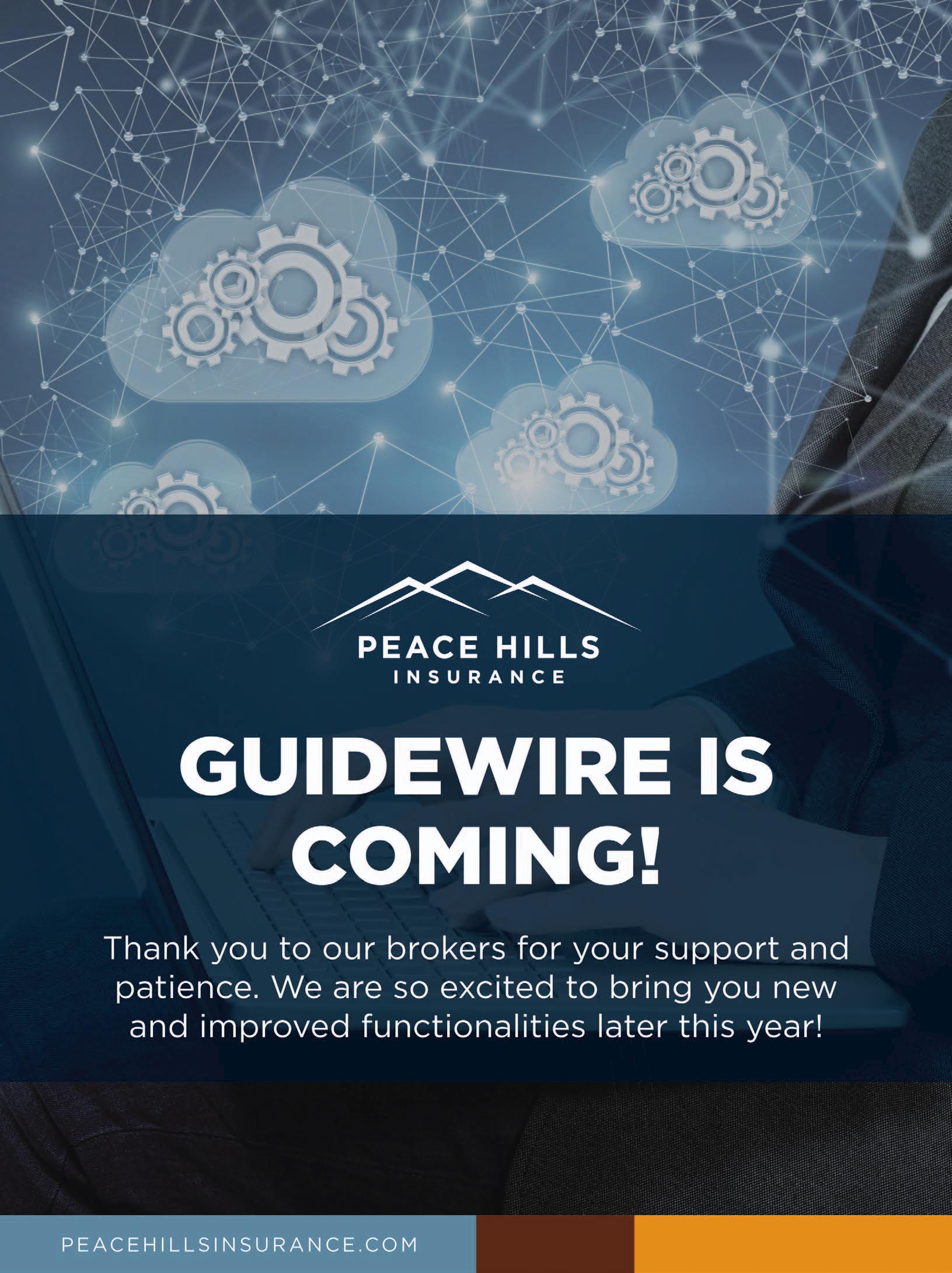

To start my research of the topic of artificial intelligence (AI) and the opportunities and challenges it presents to insurance brokers, I began with the simple online search query: “AI in insurance.” Google generated 183 MILLION results for my reading pleasure. Oh boy! After reviewing several articles and papers, common themes about AI’s uses, benefits and risks emerged.
Let’s cut to the chase. When it comes to the topic of AI and insurance brokers, the question that is top of mind is: Will AI replace me? After consulting several sources, the
consensus is no—with a few caveats. We seem to be at the “helping you do your job better” as opposed to the “doing your job instead of you” phase of AI (and the jury’s out on whether the latter will ever come to fruition).
In Forbes magazine1, Julian Teicke writes, “I firmly believe that AI is not here to replace people; rather, it is here to enhance their abilities and transform the way we work together. This is particularly true in industries like insurance, where trust and relationships play a vital role.” Teicke, an entrepreneur whose own father was an insurance broker, adds, “This foundation of trust was crucial
for providing sound consultations, especially when discussing sensitive topics like insurance coverage for life’s uncertainties. The human touch he brought to his profession cannot be replicated by algorithms.”
These sentiments are echoed by many industry leaders and pundits when it comes to the “will AI replace brokers?” question (including insurance company executives when I asked them in the Q&A article on page 12 of this issue). In a sort of “meta moment,” even the generative AI platform ChatGPT concurred, “The trust and relationships built by brokers are valuable aspects that AI currently cannot fully replicate.

 By Annette Hubick
By Annette Hubick
While AI can complement the work of insurance brokers by automating certain tasks and providing datadriven insights, the human element in the form of relationship-building, communication and personalized advice is likely to remain essential in the insurance industry. It is more probable that AI will work alongside insurance brokers to enhance their capabilities rather than completely replace them.”
Here come the caveats:
Reading between the lines, since one of the key benefits that AI offers is to automate administrative functions such as data entry, it does mean that
potential job losses in insurance organizations do exist for individuals whose roles are solely to carry out these types of tasks. Sherief Mursjidi, Technology Manager with Klix Digital adds nuance to this notion, “However, it’s important to note that AI automation does not necessarily mean the complete elimination of jobs. Instead, it can lead to a shift in job roles and responsibilities. Insurance professionals can adapt to these changes by acquiring new skills and focusing on tasks that require human judgment and empathy, such as customer service and complex problem-solving.” 2
“AI won’t replace brokers, but brokers who use AI will replace brokers who don’t.” I first heard Trufla Technology CEO Sherif Gemayel say this in a session at the 2023 IBAA convention and have seen and heard variations of that prediction repeatedly since then. “It is crucial for insurance companies to invest in employee training and reskilling programs to ensure that their workforce remains relevant and adaptable in the age of AI automation. By upskilling their employees, insurance companies can create a workforce that can effectively collaborate with AI technologies and maximize their potential,” says Mursjidi.
Eventually, using or not using AI won’t be a competitive differentiator. In an interview with Insurance Age, insurance software company CEO Fraser Edmond states, “People are unlikely to lose out to AI. However, they are highly likely to lose out to people who utilise AI better than they do.” 3
Now that we’ve discussed AI’s possible existential threat to insurance brokers, let’s review some of the benefits this technology purports to offer.
“I think there is excitement in that some of the inefficient tasks may be replaced with AI,” says Caleb Maksymchuk, president-elect of the Insurance Brokers Association of Alberta (IBAA). AI can automate time-consuming and repetitive tasks, such as data entry, claims processing and policy administration. This allows insurance brokers to focus on more complex and value-added activities, improving overall efficiency and maximizing revenue growth potential. It boils down to the old adage, “Time is money.”
AI enables brokers to analyze large volumes of data quickly and extract valuable insights. Predictive analytics can help in assessing risks more accurately, identifying trends and making data-driven decisions to optimize insurance offerings.
By leveraging machine learning algorithms, brokers can provide personalized insurance recommendations based on individual customer profiles, preferences and risk profiles. This enhances customer satisfaction and improves the relevance of insurance coverage.
AI can streamline the underwriting process by automating risk assessments and evaluating vast amounts of data to determine appropriate coverage and pricing. This can lead to more accurate risk assessments and faster policy issuance.
Virtual assistants and chatbots powered by AI can provide immediate customer support, answer queries and
guide clients through the insurance process. This improves the overall customer experience by offering quick, accessible, 24/7 assistance. A personal note of caution on chatbots: As a consumer, I often cringe when I select “chat” on a website and see that I’ll be chatting with a bot instead of a real person because a. it often seems like my question or problem doesn’t fall into the generated queries and b. I often have to repeat everything when I finally get connected with a human agent. I’d gladly wait a couple more minutes if a message popped up stating, “just a couple more minutes while agent name reviews your conversation, so you don’t have to repeat yourself.”
AI algorithms can analyze patterns and anomalies in data to detect potentially fraudulent activities. This helps identify and prevent fraudulent claims, reducing financial losses and maintaining the integrity of the insurance system.
analyzing historical data, market trends and emerging risks. Brokers can use this information to provide proactive risk management advice to clients.
AI-driven tools can optimize internal processes, reducing manual workloads and increasing overall operational efficiency. This may include automating paperwork, managing client databases and streamlining communication channels.
AI can assist in staying compliant with evolving regulations by
a significant positive impact on an insurance brokers’ client satisfaction and retention.
Like most technological advances, along with opportunities AI also brings threats and challenges. Concerns include data security and privacy, bias, ethical considerations, over reliance and a pace of change so rapid, governments’ ability to develop and adapt relevant legislation and regulation is left in the dust. In fact, On March 13, 2024, the European Union’s parliament approved the world’s first major set of AI regulations (which took three years after its law was passed).

“The trust and relationships built by brokers are valuable aspects that AI currently cannot fully replicate. ”
—ChatGPT
AI can analyze customer data to identify target demographics, preferences and behaviors. Insurance brokers can use this information to develop more targeted marketing campaigns and sales strategies, increasing the effectiveness of outreach efforts. It can also distill client survey responses to reveal coverage or service gaps, providing brokers with a detailed list of upselling and cross-selling opportunities.
AI technologies can assist in assessing and mitigating risks by
automating compliance checks and ensuring that policies align with the latest legal requirements.
AI-powered tools can continuously monitor and analyze market trends, competitor offerings and industry developments. This enables brokers to stay informed and adapt their strategies to remain competitive.
Although some of the above benefits are realized more on the company side of the insurance equation, their effects also extend to brokers—when aspects of the insurance journey that are outside of a brokers control are performed faster and more accurately, individualized and responsively, it has
On the home front, Canada’s proposed Artificial Intelligence Data Act (AIDA), part of omnibus legislation Bill C-27, the Digital Charter Implementation Act was introduced in June 2022, passed second reading in April 2023 and has been in the consideration in committee stage since September 2023 (at time of writing, they’d met over 20 times). Most of the delay is due to disagreements between stakeholders about the other two pieces of legislation included in the bill. Given the fact that AIDA is attempting to legislate an industry that seems to be changing weekly (ChatGPT wasn’t even a thing when the legislation was introduced), one can appreciate both the need and the challenges to accomplish this task.
From a broker’s perspective, there are other risks to consider, says Jonathan Brown, IBAA president “The idea of AI is certainly intriguing for
continued on page 22

continued from page 22
those who are more tech inclined, as it appears to offer some process efficiency and could improve data entry time. The concern, however, is that implementing AI could also come with its own risks regarding liability issues and E&O due to changes in oversight during processes, so I think that the approach towards implementing this technology in brokerages will be cautious.”
So, what AI tools are available to deliver the above-mentioned benefits to insurance brokers? Once again, I turned to Google, and that search produced a mere 8.1 million results. Considering AI is but one of the many changes that brokers have to contend with and that its possibilities and applications (and pitfalls) seem to expand daily, the prospect of determining which AI-powered tools will actually deliver on the potential that AI offers can seem daunting. Trufla’s Gemayel advises:
The role of insurance agents has changed dramatically by 2030. The number of agents is reduced substantially as active agents retire and remaining agents rely heavily on technology to increase productivity. The role of agents transitions to process facilitators and product educators. The agent of the future can sell nearly all types of coverage and adds value by helping clients manage their portfolios of coverage across experiences, health, life, mobility, personal property, and residential. Agents use smart personal
While most organizations likely didn’t invest heavily in AI during the pandemic, the increased emphasis on digital technologies and a greater willingness to embrace change will put them in a better position to incorporate AI into their operations.
—McKinsey & Company Report
to accommodate remote workforces, expand their digital capabilities to support distribution and upgrade their online channels. While most organizations likely didn’t invest heavily in AI during the pandemic, the increased emphasis on digital technologies and a greater willingness to embrace change will put them in a better position to incorporate AI into their operations.”
For the average Alberta broker, this incorporation is likely to proceed cautiously. “There may be some apprehensions towards what we don’t know or where to start. But that comes with anything new,” says Maksymchuk, adding, “Every change brings opportunity and that should be embraced regardless of if AI is on your roadmap now or in the future or not at all.”

“The true measure of technology isn’t just in the sophistication of its features or the immediacy of cost reductions. True value lies in the seamless blend of three pivotal benefits:
1. Direct cost savings—technologies that don’t just add to your expense sheet but actively contribute to operational efficiency.
2. Indirect benefits—solutions that enhance customer satisfaction, boost agent productivity and ensure smoother compliance, setting the stage for long-term success.
3. Strategic advantage—innovations that not only address today’s challenges but also equip you for the future’s uncertainties.”
Speaking of the future, a report by global management consulting firm McKinsey & Company, Insurance 2030—The impact of AI on the future of insurance4 , certainly paints a dramatic shift to the insurance brokering landscape:
assistants to optimize their tasks as well as AI-enabled bots to find potential deals for clients. These tools help agents to support a substantially larger client base while making customer interactions (a mix of in-person, virtual, and digital) shorter and more meaningful, given that each interaction will be tailored to the exact current and future needs of each individual client.
One might think, that’s a whole lot of change that needs to happen by 2030, but considering how much has changed in the last decade, in the last year for that matter, is the prospect really that far-fetched? The authors of the report contend that another major disrupter, the COVID-19 pandemic, has better positioned insurance organizations to adapt to the AI seismic shift. “(It) changed the timelines for the adoption of AI by significantly accelerating digitization for insurers. Virtually overnight, organizations had to adjust
Going forward, the key will lie in finding a balance between technological innovation and maintaining the human touch that is crucial in client relationships and at the core of what brokers do.
ANNETTE HUBICK operates Link PR Incorporated—a marketing and communications consulting firm—and has been the publisher/ editor of Alberta Broker since 1996. Annette@LinkPR.ca

1 Teicke, Julian; “Will AI Replace Human Insurance Brokers?”; Forbes.com; Forbes Media; Jul 24, 2023; https://bit.ly/4anXV94
2 Mursyidi, Sherief; “AI Automation: Unlocking Growth Potential for Insurance Brokers”; Medium.com; Aug 22, 2023; https://bit.ly/4cN0G5n
3 “Review of the Year 2023: Broker Insights’ Fraser Edmond”; insuranceage.co.uk; Infopro Digital Services Limited; Dec 22, 2023; https://bit.ly/3Uc9Tgk
4 Ramnath Balasubramanian,Ari Libarikian and Doug McElhaney; “Insurance 2030—The impact of AI on the future of insurance”; mckinsey.com; McKinsey & Company Financial Services; Mar 12, 2021, https://bit.ly/3VTkaPH


Not many years ago auto insurance premiums could be easily calculated and clearly communicated to policyholders. This is not the case today, as we are seeing an increase in the adoption of advanced tools, Artificial Intelligence (AI) and Machine Learning (ML), to price auto insurance policies, serve policyholders and reduce costs.
Given the advancements in these technologies, in June 2023, the Automobile Insurance Rate Board (AIRB) surveyed Alberta’s auto insurers about how advanced models are used today and understand where insurers are looking to employ them in the future.
The AIRB survey was based off a study by the National Association of Insurance Commissioners (NAIC) in the United States. The purpose of the AIRB’s survey was to:
Learn directly from industry about their use and governance of big data and AI/ML models and begin a dialogue.
Insurers may be hesitant to invest in costly advanced modeling systems
where they must implement under a strict regulatory process. As a principles-based regulator, the AIRB encourages technological innovation, and views the implementation of advanced technologies as a way for insurers to lower their costs and price risk more accurately, leading to lower premiums for Alberta drivers.
Provide historical information on the speed and areas of adoption over time.
The AIRB received responses from 12 insurer groups, representing over 90% of the private passenger vehicle market. Six key takeaways from the survey were:
1. Generally, insurers have their own internal model governance with concrete procedures in place.
Insurers reported that internal governance is robust, documented, and taken seriously. While the governance structure differs between insurers, most have the five principles outlined in our report: Fairness and Ethics; Accountability; Appropriate
The AIRB was satisfied industry is aware of the risks in using these models. We found insurers have documented model governance and consider these risks at each stage of model development.
2. Smaller insurers are unable to implement these systems.
We found 75% of insurers surveyed use AI/ML, with 100% of the largest insurer groups using or planning to use AI/ML, while none of the smaller insurers either use or plan to use it.
Common reasons cited by insurers not using AI/ML were lack of expertise/infrastructure and an insufficient volume of data. The gap in predictive power between advanced models and simpler, standard statistical models grows with the amount of data. A small insurer may not gain significant value using advanced pricing models over their current models, and the cost likely outweighs the benefits.
continued on page 26
Property owners from coast-to-coast RELY on WINMAR® to restore their homes and businesses following a disaster to pre-event condition such as: flooding, fire or weather related damage. With over four decades of experience, specialized restoration equipment and a thorough understanding of our Customer’s needs during stressful times, our skilled and experienced WINMAR® team has the knowledge to navigate the process with you while instilling peace of mind.
WINMAR®’s network of 90+ locations across Canada provides quality services 24 hours a day, 365 days of the year.





continued from page 24
3. The stage of implementation varies among insurers, even for insurers of similar size.
Insurers who have not yet implemented use of advanced models are exploring opportunities for their usage.
The most developed business area is pricing, and the least is marketing. Of the companies reporting current use:
all indicated they use or plan to use advanced models in pricing.
only four use or plan to use advanced modelling for marketing.
eight companies use or plan to use advanced models for claims and fraud detection.
4. The primary goal seems to be human augmentation, not automation. Only lowrisk tasks are completed via total automation.
For all model uses, we defined:
support, which provides information to a human,
The intention of this survey was to start a conversation directly with the industry about how and where they are using AI/ML and if they have adequate governance over their use. Based on the results of this survey, we are satisfied the industry is cognizant
75% Of Insurers Use AI/ML
as this moves away from actuarially justified rates to rates based on demand properties. This area seems to be a highly divided topic, with some insurers taking an ideological stance that it is not appropriate. Currently, no such models are in use.

of the risks associated with these models and are sufficiently proactive in their approach.
While few insurers indicated an interest, we will be monitoring the concept of price optimization closely,
augmentation which provides support and a recommendation to the human, and automation which has no human intervention.
Automation is only used for low-risk tasks, such as sending risks to risk sharing pools or assigning adjusters to a claim. Models for high-risk tasks, such as claim denial, are only providing support or augmentation.
5. The type of data used in these advanced models varies by insurer, business area, and task.
Data sources range from simple demographics like age, to telematics, weather, and crime data.
Although the AIRB does not have current plans to implement regulatory guidance, we are monitoring work done in other jurisdictions on this topic. We are keenly interested in how these models and other innovations can benefit Alberta drivers through efficiencies leading to reduction in premiums. The full report can be read on the AIRB’s website.
LAURIE BALFOUR Executive Director Alberta Insurance Rate Board laurie.balfour@gov.ab.ca
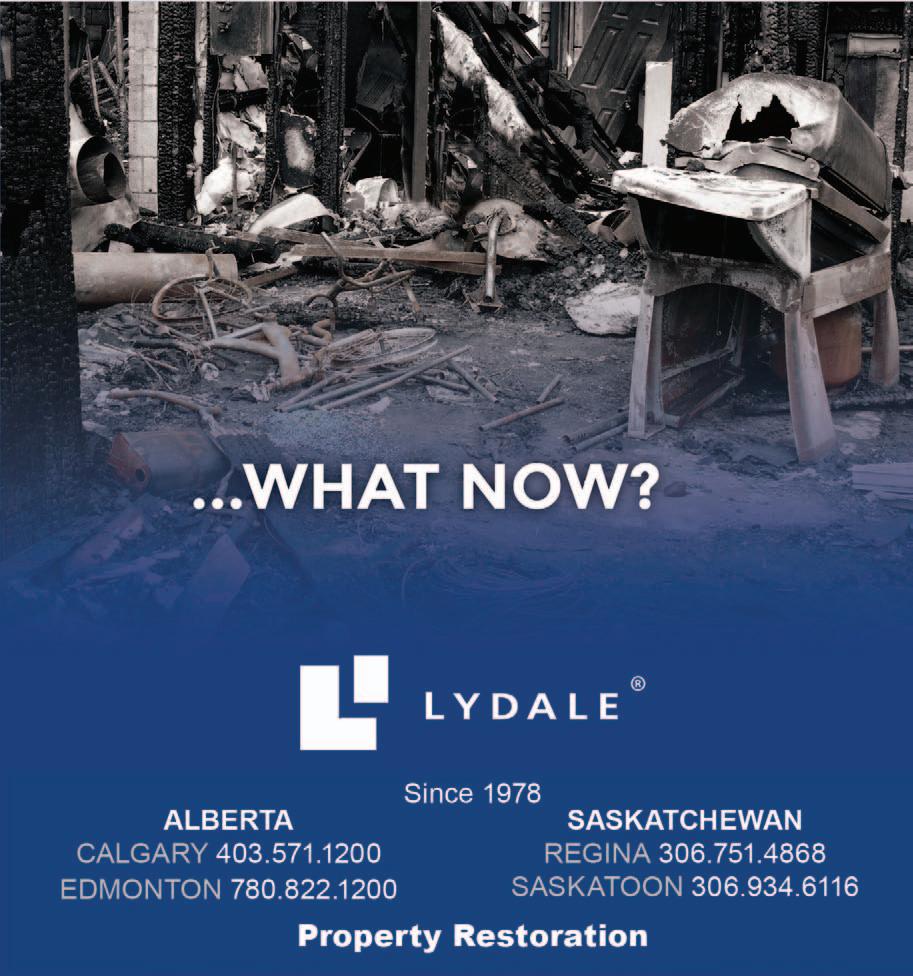


Also known as weak AI, narrow AI helps you perform specific functions. It’s focused on a single domain and operates within predefined limits. Narrow AI cannot do anything more than what they are programmed to do — they have a very limited or narrow range of competencies. Examples include voice assistants like Siri or Alexa. These lack general intelligence and cannot perform tasks outside their designated domain.
General AI, also known as strong AI or artificial general intelligence, refers to AI systems that possess human-level intelligence and can understand, learn and perform any intellectual task that a human being can do. They can adapt to various scenarios and solve problems creatively. While general AI remains a long-term objective, current advancements primarily focus on developing narrow AI systems that excel in specific areas, such as image recognition or natural language processing.
This type of AI surpasses human intelligence in nearly all aspects. It not only outperforms humans in cognitive tasks but also possesses the ability to improve itself, leading to an exponential increase in intelligence. While superintelligent AI remains largely theoretical at present, it’s a topic of interest and concern within the field of AI.
Reactive AI systems automatically respond to a limited set or combination of inputs and operate based on the current input without any memory or past
AI systems with limited memory can store and retrieve information from previous experiences to make better decisions. They have the ability to learn from past data and use it to improve their future actions. Self-driving cars that use historical data to make driving decisions are an example of limited memory AI.
This type of AI is still largely theoretical. Theory of mind AI will have the ability to understand and model the mental states, beliefs and intentions of other agents. They’ll be able to attribute thoughts, emotions and intentions to other entities and predict their behavior based on this understanding.
While still theoretical and not fully realized, this type of AI would possess human-like awareness and understanding of its own existence. Self-aware AI systems will have a sense of their own existence, consciousness and internal state. They possess selfreflective abilities and are aware of their own thoughts, actions and impact on their environment. True selfaware AI is a concept that remains largely speculative and is currently beyond the capabilities of existing technology.
Generative AI systems are capable of creating content, such as images, videos, music or text, that is nearly indistinguishable from human-generated content. They can autonomously generate new outputs based on their learned patterns and styles.
Generative adversarial networks are an example of generative AI, where one network generates content, and another network evaluates and provides feedback to improve the quality of the generated output.

Source: Abdullahi, Aminu; “Artificial Intelligence: Cheat Sheet”; techrepublic.com; TechnologyAdvice; July 14, 2023; https://www.techrepublic.com/resource-library/downloads/cheat-sheet-artificial-intelligence-free-pdf/ experiences. In fact, reactive AI systems don’t have the ability to form memories or learn from previous interactions. They simply react to the current situation or stimulus. Examples include chess-playing AI systems or recommendation algorithms.

 BY JULIANNA CANTWELL
BY JULIANNA CANTWELL
The purpose of a performance management system (PMS) is to set, measure, track, and, ultimately, improve performance of individuals and groups of employees. Employee performance reviews (a.k.a. performance appraisals) are a key part of managing performance.
What’s the point of a performance appraisal process? It’s about supporting your employees in maintaining good (if not great) performance. So, your performance appraisal conversations should be all about THEM (the employee) and their contributions to your organization.
PRO TIP: Use the “windshield principle”—25% of the formal performance review process should be looking at last year’s accomplishments/ challenges (rearview mirror, looking behind), and 75% of your meeting should be focused on the future (windshield, looking ahead—where the employee is going in their job— and life—as well as why and how they will get there (their goals, action plans and development opportunities).

Do you know why the rearview mirror is smaller than the windshield?
Because the way ahead of you is more important than the one you’re leaving behind.
Great job descriptions, which are the central tool for managing individual performance, may include key metrics that are used to measure an employee’s success in their role. Using objective measures of success can help reduce subjectivity (which is inherent in these types of conversations) when evaluating your employees.
RESOURCE: Key Performance Indicators (KPIs) and Metrics— Insurance Industry: https://
continued on page 30


Rating employee performance has been, and always will be, a contentious issue, especially if the ratings are tied to compensation (i.e., a higher score will yield merit increases, bonuses, raises, etc.). Here is a simple pros and cons analysis when considering using a rating system for evaluating employee performance (see bottom of page).
PRO TIP: If you tie pay to performance, make sure to vet your definitions of these ratings through key stakeholders.
Employees and managers dread a heavy administrative process. If the appraisal form is longer than two pages or takes longer than an hour to complete, both managers and employees may lose sight of the value of the performance review process.
RESOURCE: Performance Evaluation Template—Insurance
Industry: https://www.slideshare. net/RyanGiggs345/insurance-officerperformance-appraisal
If your organization ONLY has an annual review, consider scrapping it! Performance review meetings
“If your organization ONLY has an annual review, consider scrapping it!”
PRO TIP: Train managers on how to conduct performance review meetings: sharing positive AND constructive feedback. Importantly, ask employees what is working for them and what should change in their work environments to help them become more effective in their roles.
held only once a year are riddled with rater biases (especially the “recency effect”) and managers miss opportunities to provide coaching and meaningful connection with employees throughout the year. Consider implementing bi-annual or, even better, quarterly reviews. In a three-month timeframe, business priorities can change.
There is no such thing as a perfect performance management system in any organization. However, you may want to consider inviting your team to give feedback on your current performance management program. You could include a question or two in the review meeting, asking the employees to suggest ways to improve the performance management system, such as, “What is the most valued part of the performance process here at [ABC Company]? Why?” and “What is one thing that would make the system better?”

10
+ Easy-to-calculate percentages (like a school report card)
+ Easy to trend improvements / slippages over time
– Subjective; difficult to define differences in levels
– Can be viewed as “old-school”
5
+ Creates a “middle” (3) rating for satisfactory performance
+ Easy to track & trend
– Managers can easily use “central tendency” for marginal performers
– Communicating who deserves 4s and 5s (can get “political”)
4
+ Forces tendency (more toward + or –)
– Defining differences between low and very low performance vs. high and very high
3
+ Simple system (either – or + or ++)
– More difficult to benchmark improvements
2
+ Serves more as a communication tool between manager and employee (vs. a “report card” experience)
– Qualitative comments become key to the review process; must be strong at setting clear goals for improvement


In Gagne v Harrison, the plaintiff sued a life insurer (among others), alleging that the insurer caused them harm by creating an unsuitable financial retirement plan that included the use of life insurance contracts. In its defence, the insurer argued that insurers, unlike insurance brokers, do not have a duty to determine what products an insured needs. When the insurer persuaded the initial judge to dismiss the plaintiff’s claim for that reason, the plaintiff brought the issue to the Ontario Court of Appeal. The Court of Appeal was then asked: is it truly “settled law” that an insurer does not have a duty to determine an insured’s requirements?
The Initial Judge’s Decision
The insurer brought the matter to the initial judge on the basis that the plaintiff’s lawsuit failed to disclose a reasonable cause of action against the insurer. Causes of action are essentially recognized types of claims (e.g. breach of contract, negligence, etc.), and each cause of action is made up of elements that a plaintiff will have to establish in order to be successful in a lawsuit. As a procedural matter, a lawsuit can be dismissed if a plaintiff does not allege a reasonable cause of action.
Here, the insurer argued that there was no duty on an insurer to know an insured’s coverage requirements and that, therefore, there was no reasonable cause of action and the lawsuit had to be dismissed. The judge was persuaded that “the litigation was really about bad advice, not a bad product or the faulty delivery of insurance products,” and dismissed the lawsuit against the insurer. The plaintiff appealed.
Reversal at the Court of Appeal
The Ontario Court of Appeal allowed the plaintiff’s appeal. Although the Court of Appeal agreed with the judge that the plaintiff’s lawsuit was defective because the plaintiff’s statement of claim did not
articulate all of the necessary elements of the various causes of actions against the insurer, the court disagreed that “settled principles of law distinguishing between the obligations of insurers and brokers and agents” dictated that there was no cause of action against the insurer.
That is, the court did not agree “that there is any general principle of law that an insurer will never owe a duty to an insured with respect to the suitability of an insurance product.” Although there were cases where an insurer’s duty to an insured did not exist on the particular facts, the initial judge incorrectly took this to mean that the duty could never exist.
In this case, since the judge had found that the duty could never exist, the plaintiff’s lawsuit against the insurer was deemed to be inherently defective and was dismissed. The Court of Appeal reiterated that the court had only been asked to make sure
that the plaintiff’s lawsuit against the insurer met the minimum procedural requirements of an adequate statement of claim, not to evaluate the plaintiff’s allegations on the merits.
The Court of Appeal agreed that the plaintiff’s statement of claim was inadequate; however, the plaintiff could still remedy this deficiency. The court stated: “Leave to amend a statement of claim should be denied only in the clearest of cases, when it is plain and obvious there is no tenable cause of action, the proposed pleading is scandalous or vexatious or there is non-compensable prejudice to the defendants.” The Court of Appeal found that the plaintiff’s statement of claim contained tenable causes of action against the insurer, although their essential elements had not been properly set out; for that reason, the Court of Appeal granted the plaintiff permission to amend their pleadings.
The initial judge’s decision in Gagne v Harrison would have meaningfully narrowed the scope of insurers’ potential liability to insureds. However, as the Ontario Court of Appeal clarified, there is no categorical rule that insurers cannot be liable to insureds under a duty to determine the insured’s requirements. The exact details of the duty may still be the subject of argument and may turn on specific facts, but the Ontario Court of Appeal has stated clearly that the duty cannot be dismissed out of hand.



 BY JENNIFER HAMILTON
BY JENNIFER HAMILTON
Hiring engaged and competent staff is just the start of the talent acquisition battle. Education is one of the major pieces in the puzzle when it comes to successfully developing new talent. It is no secret that one of the major hurdles in getting new brokers up and running is the accessibility and pass/fail rate of the Alberta licensing process. As the IBAA’s broker relations representative, I get to sit down with our members and hear their perspectives. Unfortunately, during my visits the same frustrations are voiced time after time: the process is too complex, it’s inaccessible and the failure rate is too high.
I also have my own perspective on the process, given that I have experienced licensing from both sides of the coin. As someone who has gone through the processes of Level 1 and Level 2 licensing, and who completed my Canadian Accredited Insurance Broker (CAIB) designation at a time when it wasn’t considered a “benefit” to my license, I have the unique position on how best to navigate the system. Having done both licensing and CAIB, here is my assessment of the
experience and my best advice for those wanting to guide new brokers through the process.
This is my go-to option when discussing career pathways for those who are brand new to the insurance industry or struggling to pass their Level 1 exam. Not only is the CAIB program a nationally recognized professional designation and licensing equivalency but the exam itself provides for a more in-depth knowledge and understanding of all areas of property and casualty insurance. As with all options there are some pros and cons.
CONS: The equivalency of a Level 1 license requires the completion of the CAIB 1 and CAIB 2 exam, which is a more costly adventure than the licensing counterpart. This is especially pertinent if the cost of the courses are coming out of the licensee’s pocket. As well, you are studying for and taking two exams as opposed to one. And—a sticking point for some—the exams have a mix of multiple choice, short answer and definition questions.
PROS: Regardless of the cons mentioned above, I found that the short answer questions prepared me for day-to-day usage of my license by giving scenarios one is likely to come across. I actually found myself taking the knowledge I learned to answer those scenarios. Not only that, but if you can explain the information in layman’s terms, there is a likelihood you’ll get partial marks if you show an aptitude for understanding how the coverage works. As well, it only requires a 60% scoring, a lower pass mark than the traditional licensing exam. On top of that, you can re-write your exams as need be. There is no “three strikes you’re out” policy as with the licensing exam.
This is notoriously hailed as the “quick, easy and more affordable” option. However, there are some major drawbacks.
CONS: At 70%, the passing score is higher than the CAIB, and the answers are either right or wrong. There are no partial marks as one would have in the CAIB exam. If you do not pass the license exam after the
third try, you have to wait another six months to write again.
PROS: You only have the one exam you need to pass, which gets you licensed and on the front lines quicker. Additionally, the price for materials and writing the exam are considered much more budget friendly.
I understand that cost will always be front of mind when thinking about staff development. However, for me, the value of the CAIB learning experience exceeds the cost of an exam. When thinking about the route to licensing staff, think about it this way: do you want a “broker,” or do you want a well-versed broker?
No matter which path appeals to you more, IBAA ensures that both options are available to you within our professional development offerings. The association provides standard training via self-study or an online after-hours immersion course. We also offer licensing courses through online immersion. Licensing exams are only offered through the Alberta Insurance Council at the main locations in Calgary, Edmonton, Grande Prairie, Lethbridge, Fort McMurray, Medicine Hat or Red Deer. CAIB exams, however, can be taken using virtual proctor. We have also started to offer in-person proctoring once a month at our Edmonton office.
Regardless of the licensing route you choose to put your new brokers through, they will not be 100% ready to go out into the world and start writing business. They will still need some buffing and polishing around those edges. More tailored educational support post-licensing will help them build confidence to service clients at the high level. The IBAA has a host of education programs, such as our Broker 101 series that can support and help your brokers build confidence and fulfill their potential. Broker 101 is our eight-module post-licensing course that covers essentials broker knowledge not included in the licensing content. Our other on-demand offering, the Commercial Boot Camp series, is also a
benefit for those looking to start off in the commercial insurance industry.
In addition, our monthly Errors & Omissions courses teach brokers how to protect themselves and their employers from errors that are within their control. These are great courses to mix into the CAIB or licensing routes to help support the material and see the big picture.
In summary, each person has a different way of learning. Sometimes one option is more beneficial than the other, and being able to work with
your new broker and understand their learning style may help gauge which option would work best for everyone. My two cents would be to bear in mind that the long-term benefits to the individual (and your brokerage) will always be of greater value than focusing on the short-term cost.


No matter the glass, we have you covered.

Picture the scenario where you must suddenly abandon everything, gather your family, and evacuate your work and home. This fear of leaving home or community is shared by 43 per cent of Albertan residents, as revealed in a recent survey conducted by First Onsite Property Restoration.1 In the Weather and Property Survey, three quarters of Alberta residents (76%) also admit to having fears about wildfires and wildfire smoke.
Unfortunately, each year these concerns are becoming more of a reality. Just recently, the Alberta government declared an early start to this year’s wildfire season—10 days before the usual March 1 start date. As of March 15, there were 54 ongoing wildfires in the province. This after last year’s record-breaking wildfire season in Alberta that saw 1,092 wildfires burning a total of 2.2 million hectares.
Certainly, when we get a major fire close to homes or businesses, there is a risk, not only of evacuation and an impact to residents’ lives, but a looming threat of business interruption as well. Nevertheless, the early start and frequency of this year’s fires is notable, and the unpredictability of when and where these blazes are going to start is concerning to many in the region. Large fires can start close to populated areas with no notice, and it’s crucial to be prepared.
The number one piece of preparedness advice is awareness: always listen to authorities. If a community is on evacuation alert, residents need to be ready to go at the drop of a hat, equipped with a full tank of gas and a packed bag. Moving quickly can protect lives. For businesses, preparation can be a complex matter but is an important step toward mitigating risk and minimizing impact of a wildfire event.
Wildfires can also have a substantive and detrimental impact on air quality. Oftentimes we see
particulate levels in the air in major metropolitan areas that are 30 or 40 times the normal safe limit because of wildfire smoke even though the fire can be as far as 1,000 kilometres away. Depending on wind direction, the result can be a smoke-filled metropolitan area, such as we saw in several Canadian provinces and U.S. jurisdictions last summer.
For business owners, employees and residents, breathing in wildfire smoke can be dangerous, and providing clean air for employees, customers, tenants and residents is a priority. Employers can take steps to protect workers, including allowing for flexible work schedules on low air quality days and installing additional air scrubbing equipment.
Much discussion and action has taken place to protect, prepare and build communities to be more resilient to fires. Some of the strategies that are being deployed include the use of new building technology with paperless materials, mould resistant materials and more
sustainable products such as steel-shake roofing. Other techniques include the use of fire-resistant external building materials and wood-free landscaping products.
Wildfires have highlighted the risks of fire and smoke damage to commercial and residential properties. It’s important for residents and business owners to be aware of the tangible and low-cost ways they can protect their lives, properties and assets from wildfire. This includes selecting fire-resistant roofing materials, clearing away gutter debris, removing nearby coniferous trees, pruning trees, keeping the lawn mowed, using fire smart landscaping and creating an evacuation plan.
Additionally, it’s critical to ensure that businesses and homes have adequate insurance coverage. Of note, 57 per cent of Albertans in the Weather and Property Survey were concerned about whether their insurance was at the right level. Policyholders should check their policies or ask their insurance representative to confirm their limit.
Ultimately, catastrophes provide an occasion to reshape our thinking about how our communities are planned and constructed to provide a safer, more sustainable environment. While community planners take into consideration how development can coexist with natural areas, communities and property owners can plan for events and take extra steps to prepare in advance to protect properties, reduce business interruption and safeguard lives.

JIM MANDEVILLE is SVP, Large Loss, First Onsite Property Restoration. He has spent the greater part of two decades mitigating fires and disasters for businesses and homeowners, including in Alberta during the Slave Lake, Fort McMurray and 2019 Alberta wildfires. For more information, contact jmandeville@firstonsite.ca or www.firstonsite.ca
1 https://www.globenewswire.com/newsrelease/2024/03/19/2848410/0/en/ Canadians-fear-climate-change-springflooding-and-smouldering-wildfires.html

You may have never thought about the importance of standardizing data, but it plays a major role in making our lives easier. Take the example of a supermarket: almost everything you buy comes with a barcode. Why is this important? Managed barcodes allow stakeholders throughout the supply chain to use the same ”language” when they’re talking about an item. This form of standardization enables systems to talk to each other about the same food item with little or no human intervention required.
Everyone benefits from standardizing data. Customers have a seamless, hassle-free experience making their purchases. Manufacturers, distributors and store owners obtain valuable data insights regarding product inventory, customer purchasing behavior and marketing opportunities. Like the success of barcodes in the grocery sector, the property and casualty (P&C) insurance
industry benefits in the same way by using CSIO’s EDI and XML standards.
CSIO’s standards are the complete source for data elements that are used to exchange information for personal and commercial lines. Using the same data standards, brokers and insurers are able to exchange accurate information between their customer management systems. Data elements such as a policyholder’s name, for example, won’t be confused with the name of the broker. The CSIO standards are designed to handle business messages such as eDocs, automobile, property, liability, cyber, claims and billing.
Even though there is a complete data set for standardized coverage codes, many insurers still use proprietary “Z-codes” to identify
coverages on a policy. These codes fall outside recognized industry standards. While they are often used for temporary purposes or legacy system workarounds, Z-codes are not required nor are they a quick and easy solution. In some cases, an insurer uses a Z-code even when a standard code exists, creating duplicate codes. Too many Z-codes represent coverages today, creating obstacles for brokers to process requests, run accurate reports and access an insured’s information.
Businesses need better ways to get value from their data and stay at the forefront of innovation. Insurance is no different: brokers must tailor their products to customers’ needs. By implementing standardized coverage codes, all stakeholders can realize these benefits:
• Accurate reporting
• Targeted marketing
• Improved customer experience
• Operational efficiency
• Seamless data exchange
The National Standards Working Group, comprised of CSIO members, meets monthly to review and approve submitted requests for new codes, called maintenance requests (MRs), to reflect changing business requirements and more product offerings. The working group meetings give members a frequent, agile process to create new industry-wide codes, rather than introducing a Z-code. As products evolve and business needs change, the data standards used to transmit insurance information between brokers and insurers must be continuously updated.
CSIO insurer and broker management system (BMS) vendor members can request that a Z-code be eliminated by submitting an MR to csio.com. The MR will be reviewed by CSIO’s standards team and then be added to the agenda for the next National Standards Working Group meeting. Approved MRs can be programmed in members’ systems immediately, eliminating the need for Z-codes.
If a broker receives a Z-code in a download from an insurer, they can forward the details to standards@csio.com.
CSIO also works closely with insurers to analyze their Z-codes and help identify which ones can be replaced with standard codes going forward. Insurers who demonstrate to CSIO that they use only CSIO standard codes in data exchange services with brokers, can apply to attain CSIO’s compliance certification.
All of this means brokers can expect to see a sustained decline in Z-codes that promises better customer data in their BMS.
To stay up to date on the progress of Z-codes and other technology initiatives, sign up for an account at csio.com. You’ll start receiving our monthly newsletter and have access to CSIO’s professional development courses, webinars and other resources. Membership to CSIO is a free benefit included as part of your IBAA membership. Also, remember to follow us on our social channels.
DANIEL
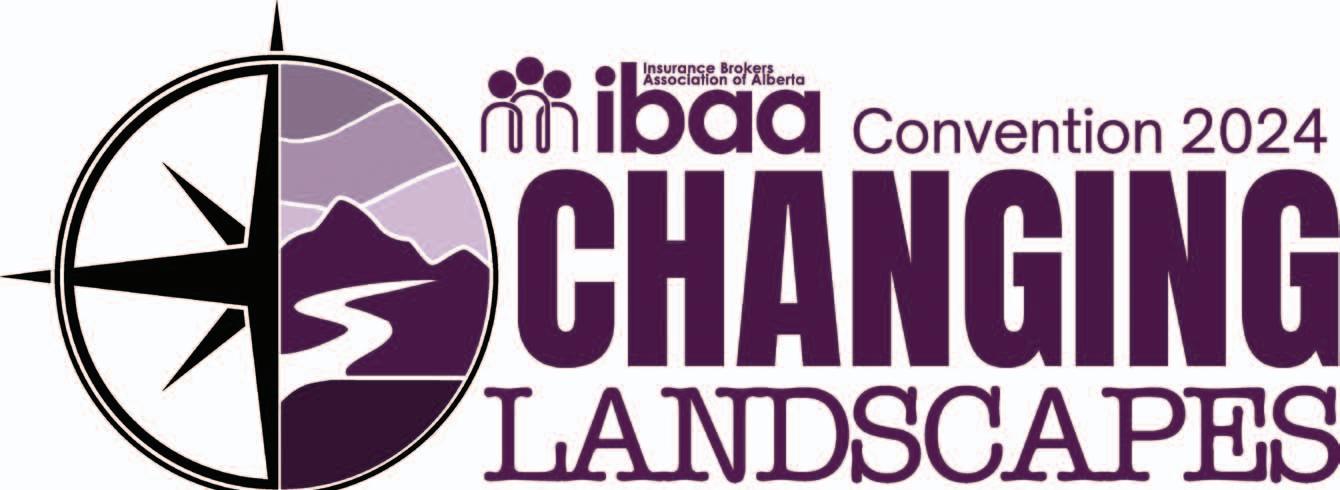

Bringing together insurance brokers and their industry partners, IBAA’s 2024 convention attendees will explore ideas, connections and opportunities that will help them navigate the industry’s changing landscapes.

SALES & MARKETING
Dear Insurance, We Need to Talk, Your Millennial BFF
SUNDAY 12:00–1:00 PM | 1 CE HOUR
Digital transformation expert Ema Roloff will discuss some of the biggest challenges in our industry. She’ll cover customer relationships, the talent gap and what it takes to implement technology in a way that allows us all to feel more human.

Implications and Strategies for the Insurance Sector
SUNDAY 1:15–2:15 PM | 1 CE HOUR
Bill Syrros, the exponential labs leader at BDO Canada, will delve into the transformative role of Generative AI in the insurance sector, offering a comprehensive overview tailored for insurance brokers.

Mental Wellness in Today’s Organizations
SUNDAY 2:30–2:15 PM | 1 CE HOUR
TOWARD GENERAL & ADJUSTER LICENSES
Organizational psychologist Dr. Laura Hambley-Lovett will share the latest trends and proactive tools to better equip leaders to foster mental wellness in themselves and their people.


SUNDAY 3:45–4:45 PM | 1 CE HOUR
TOWARD GENERAL & ADJUSTER LICENSES
With direct writers’ large marketing budgets and a population that increasingly seeks insurance online, are brokers doomed to continue to lose market share? Drawing on his decades of industry experience, Tom Reid will share how brokers can reverse the trend.

FUTURE-PROOF PASSPORT
Build Better Relationships in a Changing Landscape
MONDAY 8:30 –9:30 AM | 1 CE HOUR
In today’s changing landscape, your competitive edge is how effectively and efficiently you connect with others. In this empowering, forward-looking keynote, famed entrepreneur and anthropologist Shane Feldman goes beyond the hype and speculation to reveal a fundamental truth: In today’s unpredictable landscape, community and relationships are what will set you apart.


MONDAY 11:00 AM–12:00 PM | 1 CE HOUR

Gain knowledge and skills that will help you help your clients be resilient to a cyberattack.
KPMG’s Adil Palsetia (financial services sector leader) and Vivek Jassal (cyber resilience lead) will share their experience and expertise.

SALES & MARKETING
Creating Cross
Sell Value for Our P&C Partners & Members
TUESDAY 8:30–9:30 AM | 1 CE HOUR
TOWARD GENERAL, ADJUSTER & LIFE LICENSES
Scott Knight , vice president group benefits distribution with Wawanesa, will dive into the cross-sell opportunities across the insurance spectrum and what you’ll need to do to implement this strategic initiative in your brokerage.

TALENT ACQUISITION
NAVIGATING THE TALENT TERRAIN
Insights into Modern Hiring & Employee Engagement
MONDAY 2:45–3:45 PM | 1 CE HOUR
Hiring consultant Shelley Tobin will present a practical look at the current job market and discuss the steps needed to attract, hire and keep great staff.

TUESDAY 9:45–10:45 AM | 1 CE HOUR
Laurie Balfour, executive director of the Alberta Automobile Insurance Rate Board and David Sorensen, deputy superintendent of insurance will provide a regulatory update followed by a Q&A session.

Dialogue, Networking & Entertainment


SUNDAY 9:00 AM
Brokers and sponsors will eat, visit, putt and play an 18-hole round of golf at the worldrenowned Banff Springs Golf Course. Registration opens at 9:00 a.m. with a 10:00 a.m. Shotgun start. RAIN or SHINE, golfers of all skill levels and abilities are welcome.

Peace Hills Party
SUNDAY 7:00 PM–12:00 AM
Celebrate Cinco De Mayo with your convention amigos, new and old, with a night of Mexican food, drinks and music. Get into the fiesta spirit by dressing in the colours of the Mexican flag: red, white, and green.

Executive Panel
MONDAY 9:45–10:45 AM | 1 CE HOUR
Join high-level leaders from Aviva, SGI and Wawanesa for a moderated discussion around key industry topics and current events.

MONDAY 1:00–2:30 PM | 1.5 CE HOUR
This session is your opportunity to share your concerns and perspectives about the industry with your peers. Come prepared to ask questions. The 2024-2025 IBAA board will also conduct their official swearing in and member dedication during the session.

MONDAY 6:00–10:00 PM
Join your fellow industry professionals in the Van Horne foyer in preparation for the night’s big event. Drinks will be served and a photographer will be present. Then enjoy the Around the World themed gala celebrating 2024 IBAA president Caleb Maksymchuk’s favourite travel destinations: Thailand, England, Morocco, Italy and Hawaii. The evening will also include the presentation of the first annual IBAA Awards for Distinction. An entertaining round of dueling pianos will cap off the festivities.
Dialogue, Networking & Entertainment


Wawanesa
MONDAY 10:00 PM–12:00 AM
As your President’s Gala adventure draws to a close, make your next destination the Wawanesa After Party, a perfect night cap to your evening. Music, cocktails and soft seating await your arrival.

TUESDAY 12:30–4:30 PM
The IBAA convention trade show is an opportunity for brokers and industry partners to connect, network and explore what’s new in the industry.

TUESDAY 6:00–9:00 PM
Enjoy food, drink and fun with your fellow delegates as you close out the convention in 90s style.

TUESDAY 11:00 AM–12:00 PM
Take your networking game further by participating in our newest addition to the convention program. This year, Sandbox, Travelers, Opta and Intact will be available for small-group connection sessions. Select the 30-minute sessions you want to attend and come prepared to talk.

TUESDAY 9:00 PM–12:00 AM
For those who want to ride that hospitality wave even longer, enjoy more cocktails and fun at this 90s-themed after party!

 BY JAMIE JOHNSTON
BY JAMIE JOHNSTON
If you are new to the insurance industry or broker profession you many not yet have heard about the Professional Young Insurance Brokers of Alberta (PYIB). PYIB is a subcommittee of the IBAA that is geared toward supporting young professional brokers.
The goals of the PYIB board are to create and facilitate engaging networking opportunities, help ambitious young professionals accelerate their careers and develop the next generation of industry leaders.
To accomplish these goals the PYIB board supports new recruits to the insurance industry. PYIB acts as a resource for professional development, industry involvement and political action. Often this takes place at events hosted by PYIB. These events provide a venue for young brokers to share their concerns, ideas and hopes for the future of this industry with their peers.
These events are beneficial to new professionals as they are often in a

Create and facilitate engaging networking opportunities.

Help ambitious young professionals accelerate their careers.

Develop the next generation of industry leaders.
more casual setting and atmosphere than other organizations’ events, allowing for a less intimidating environment. Additionally, they almost always include not only fellow brokers but also other industry professionals, providing excellent opportunities to grow relationships with underwriters and adjusters you may work alongside in your day to day. Many PYIB events involve an educational component as
well—this can come in the form of presentations, workshops or keynote speakers. Some of these educational events are accredited to provide even further value to young professionals.
Over the past year PYIB has successfully hosted a variety of events that have functioned as a venue for connection amongst young brokers. Some events include ‘Boilers and Beers’ networking nights, curling bonspiels, an unforgettable stampede hoedown party and a golf tournament!
PYIB has recently welcomed our new board members for the next term, and we have a few exciting surprises coming in 2024! If you’re looking to engage with like-minded young insurance professionals and accelerate your career keep an eye out for upcoming PYIB opportunities!
JAMIE JOHNSTON Director
